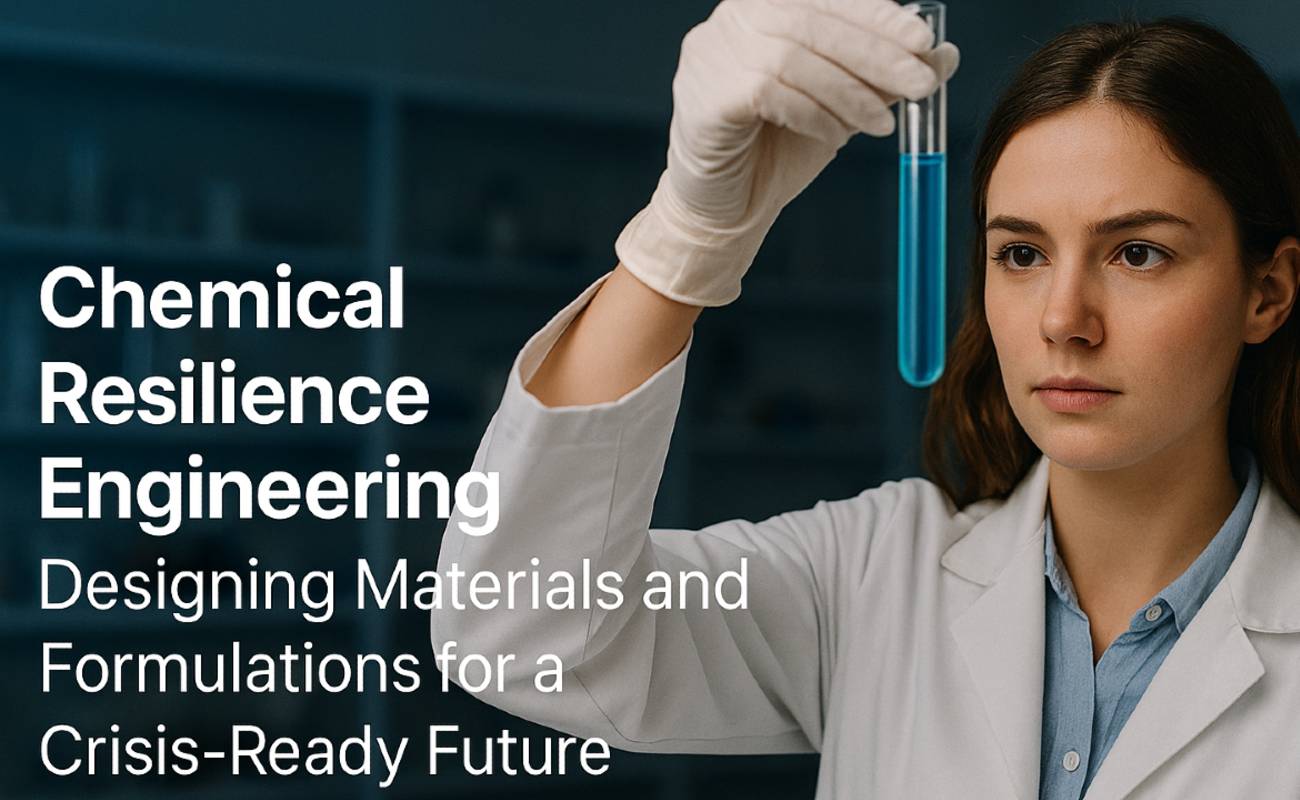Chemical Resilience Engineering: Designing Materials and Formulations for a Crisis-Ready Future
What do adhesives in war zones, coatings in space missions, and surfactants in flood-affected zones have in common? They all represent a new design mindset formulations for failure scenarios.
Welcome to the age of Chemical Resilience Engineering, where we’re not just optimizing for cost or performance anymore we’re building systems that withstand shock, recover fast, and adapt to instability.
Why Resilience Is the Next Frontier in Chemistry
The global chemical industry is built on predictability stable supply chains, controlled production environments, reliable regulations. But those assumptions are no longer safe:
· The war in Ukraine disrupted ammonia and acetone supplies globally.
· Extreme weather in Texas froze petrochemical feedstocks overnight.
· The Red Sea and Suez disruptions threw timelines off by weeks for API manufacturers in Asia.
So chemical companies are shifting gears not just to survive, but to thrive in volatility.
According to McKinsey’s 2024 report on chemical supply chain strategies, resilience is now ranked above cost-efficiency in executive planning among specialty chemical firms in North America and Europe.
Material Science at the Edge: Formulating for the Unexpected
Let’s talk specifics because resilience isn’t a marketing slogan. It’s about materials that perform under duress:
1. High-Entropy Ceramics (HECs)
HECs, such as ZrHfTiNbTaOₓ compounds, are showing exceptional thermal and oxidation stability up to 1800°C. These are now being considered in chemical reactor linings and extreme-environment catalysis, especially in space and defense sectors.
2. Perfluoropolyether-Based Lubricants
In mission-critical electronic adhesives and aerospace seals, PFPE-based lubricants (like Krytox™ by Chemours) resist vacuum, radiation, and thermal cycling perfect for spaceborne electronics or offshore energy systems.
3. Polyimide and PEEK Coatings
Kapton® (polyimide) and PEEK-based coatings survive cryogenic to 300°C swings, making them ideal for electric vehicle battery seals and polar-region chemical sensors.
4. Responsive Hydrogels for Flood Zones
Formulators in Bangladesh and Vietnam are now incorporating pH- and salinity-responsive hydrogels in sanitation and packaging systems that must survive monsoon-driven infrastructure collapse.
Process Resilience: The Rise of Decentralized & Flexible Production
While global chemical production still relies heavily on megasites, companies like Evonik, DSM, and LanzaTech are investing in microfactories and modular synthesis systems.
Why?
· They can quickly switch production between APIs, solvents, and excipients.
· They’re powered by renewable energy or local biomass.
· They de-risk geographic over-concentration, especially relevant in geopolitically sensitive zones like Taiwan or the Middle East.
One of the standout examples is Evonik’s “Veramaris” facility, co-developed with DSM in Slovakia, which produces omega-3 fatty acids from algae in a fully modular, closed-loop bioreactor system.
Formulating for Supply Chain Chaos
When shipping lanes break down and raw material ETAs become guesses, formulators must get creative:
· Ingredient Redundancy Mapping using digital twins (e.g., AspenTech, AVEVA) to ensure every formulation has 3 viable ingredient substitutions based on availability and local regulations.
· Circular Chemistry: Using in-house waste streams as alternative feedstocks—like Eastman’s methanolysis depolymerization of polyester to recover ethylene glycol.
· Blockchain Traceability: BASF’s Track & Trace system for palm-derived surfactants now allows live traceability, proving ethical sourcing and real-time inventory insight.
Packaging and Adhesive Resilience Under Pressure
· Polyurethane Reactive (PUR) Hot Melts are being reformulated to retain adhesion after thermal shock, immersion, and mechanical impact.
· Flexible barrier films now include multi-layer EVOH-PE designs with oxygen scavengers for disaster relief packaging.
· Thermo-reversible adhesives are making inroads in electronics, enabling quick repair or repurposing after damage, especially in critical systems post-blackout.
Resilience Meets Sustainability: A Chemical Tightrope
Resilient materials can’t come at the cost of sustainability.
· Solvay’s non-fluorinated water repellents are replacing PFAS in rugged textiles and building wraps delivering similar resilience with green chemistry credentials.
· Biobased nylons (e.g., PA 11 from castor oil) are being explored for high-flex applications in harsh desert conditions by companies like Arkema.
This intersection durability with biodegradability, resistance with responsibility is now the sweet spot for innovation.
What’s Coming Next
The most advanced companies are creating dedicated “resilience task forces” cross-functional teams of formulation scientists, regulatory leads, and supply chain strategists.
Real developments to watch:
· AI-powered risk simulation for formulation recipes under stress conditions (using platforms like Citrine Informatics)
· Resilience scoring frameworks for raw materials
· Pre-authorized substitution databases in QC workflows to enable agile manufacturing switches
According to a 2024 Frost & Sullivan analysis, the global market for resilient chemistry solutions is expected to grow at 13.4% CAGR through 2030.
Don’t Just Read the Future Formulate It
If you're ready to start building more robust, shock-proof products and chemical processes, stay tuned.
OnlyTRAININGS is launching a new masterclass: “Crisis-Proof Formulations: Engineering Resilience Into Chemical Products.”
From ingredient flexibility to modular production strategies and resilient coating systems, this training is your deep dive into the world of shock-resilient chemistry.
To join the waitlist or pre-register create your free account today.
Remember "Resilience isn't optional anymore. It's the new baseline"
See you next week,
ChemIndustry360 Editorial Team
Weekly newsletter powered by OnlyTRAININGS

